SEO Guide For Travel Agency
Are you looking to grow your website traffic and increase online visibility and reach potential travelers who are actively searching for destinations, accommodations or travel services.?
Worry not! We made this guide with detailed research and insights from our own implementations on client’s websites. Let’s get started.
Why You Need SEO for the Travel Company
Today’s travelers rarely trust TV ads or billboards, instead they just Google “best summer trip ideas in Europe” or “affordable vacations in Asia”.
If you’re running a travel agency, organizing tours, or even managing a travel blog, it’s crucial to ensure your business gets noticed online. Since most people begin their travel search online, investing in search engine optimization for travel websites can make a big difference in helping your site show up when potential customers are looking for travel services.
For travel agents, SEO is equally important, which allows you to stand out and connect with people who need your expertise.
Following the right SEO tips for travel website optimization can help you reach these potential customers at the right time.
According to a recent BrightEdge report, organic search drives 53% of all website traffic, showing that a powerful SEO strategy for travel websites isn’t just optional; it’s your main driver of visibility, leads, and sales.
How to Do SEO for the Travel Agency (Step-wise Guide)
Before we jump into the steps, please remember that the SEO implementation for travel websites is about combining user-friendly experiences, smart keyword strategies, content planning for your audience, and technical brilliance to stand out in a competitive space.
If you already have a travel website then Skip to Step 2!
Step 1: Create a Travel Website and make it ready for SEO
- Create a user-friendly site: Your site must be easy to navigate for people booking trips or researching itineraries.
- SEO-friendly theme: Choose lightweight, fast-loading WordPress themes.
- Mobile-friendly: More than 60% of travel bookings happen via mobile devices.
- Plan your website structure: Use clear categories like “Destinations,” “Travel Tips,” “Packages.”
- Use a descriptive URL structure: Instead of using generic URLs like travel.com/page?id=123, go for something more descriptive and relevant, like travel.com/european-summer-trips-2025.
- Make sure you’re using HTTPS: Secure websites are trusted more by Google.
- Optimize headings and subheadings: Help both users and Google understand your content better.
Step 2: Set Up Your Website for Google Success
- Set up Google Search Console: Google Search Console is a free tool that helps you monitor your website’s performance in search results. It provides insights into which pages are performing well, alerts for issues like crawling errors, and allows you to track the impact of your SEO efforts.
- Create and Submit a Sitemap: A sitemap is a file that lists all your important web pages. Submitting it to Google ensures that search engines can easily discover and index your pages, helping improve visibility and discoverability in search results.
- Make Sure Your Site is Indexable: Ensuring your site is indexable means that search engines can access and include your pages in search results. Avoid accidentally blocking pages with a “noindex” tag, which would prevent them from appearing in search engine listings.
- Add Schema Markup: Schema markup is a type of code that helps search engines better understand your content. Adding it to your website especially for events, articles, reviews, or FAQ to enhance your search result listings with rich snippets, improving visibility and click-through rates.
Step 3: Set Up Visibility Beyond Google
While Google dominates in the search engine space, you should also consider targeting Bing, Brave, Safari, and Yahoo users.
- Submit your website to Bing Webmaster Tools.
To submit your website to Bing Webmaster Tools, first, sign in to your Bing Webmaster account or create one. Once logged in, click on “Add a Site” and enter your website’s URL. Next, verify ownership of your site by following one of the provided verification methods (as shown in screenshot below). After successful verification, your website will be submitted and you can start tracking performance and gaining insights through Bing’s tools.
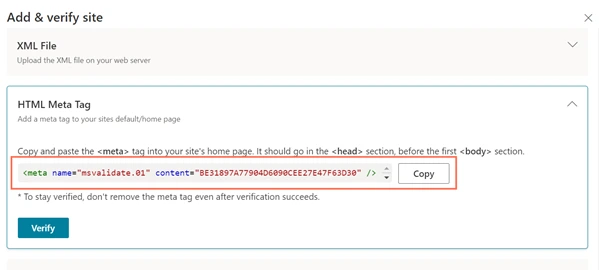
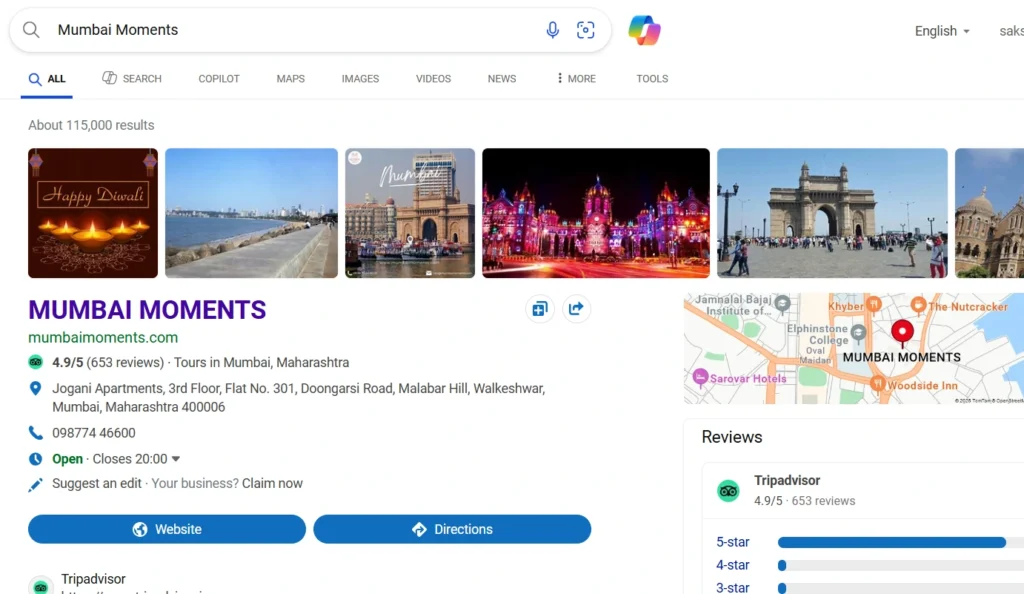
As you can see above, we have created the profile on Bing for a travel company ‘Mumbai Moments’ to increase the site’s visibility.
- Explore Brave Browser’s growing SEO opportunities.
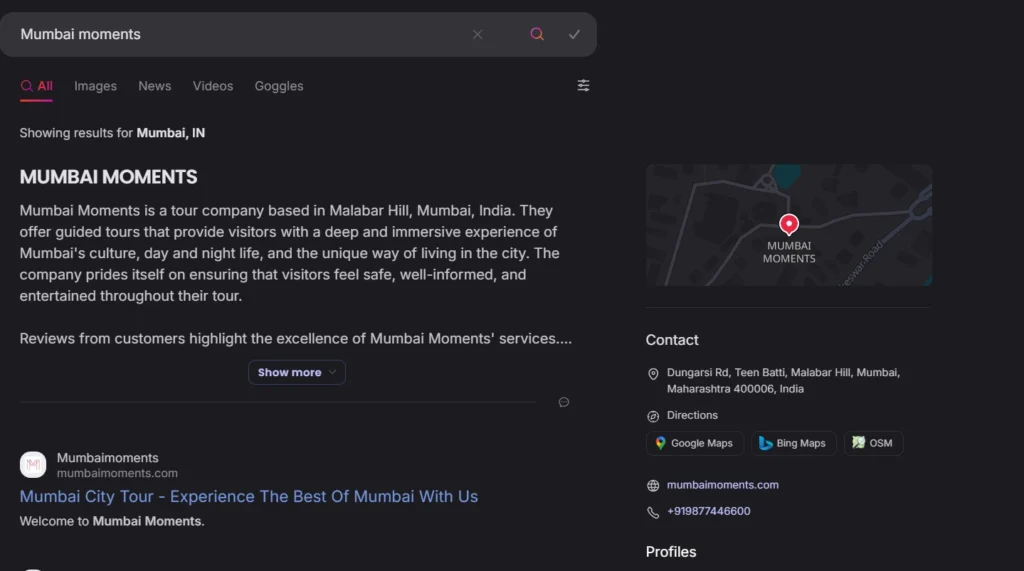
Above screenshot shows the profile of Mumbai Moments on Brave search engine.
- Optimize for Yahoo SEO.
Yahoo Search is now powered by Bing. So all webmaster tasks for Yahoo-including site submission, sitemap management and URL submission are handled through Bing Webmaster Tools.
Step 4: Technical SEO for Travel Websites
- Ensure Mobile-Friendliness: Since most travelers browse and book trips on their mobile devices, it’s essential that your site is responsive, meaning it adjusts well to different screen sizes and loads quickly on smartphones and tablets.
We worked closely with Mumbai Moments to ensure their website is fully optimized for mobile devices. This included streamlining their design for faster load times, ensuring that all images and content adjust seamlessly across different screen sizes, and simplifying navigation for mobile users. By making the site mobile-friendly, we helped Mumbai Moments provide a smooth and enjoyable browsing experience for travelers on the go, ultimately increasing engagement and conversion rates.
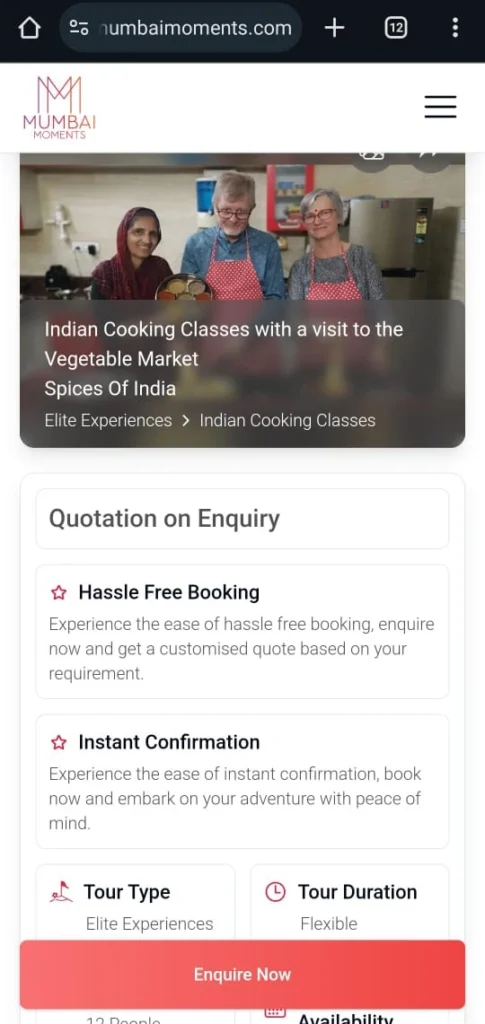
- Boost Page Speed: Faster-loading websites provide a better user experience and reduce bounce rates. Use tools like GTmetrix and pingdom to analyze and improve your page speed by optimizing scripts, reducing server response time, and minimizing unnecessary code.
- Compress Images: Large images slow down page load times, which can frustrate travelers. Compress images without sacrificing quality to improve speed and provide a seamless browsing experience.
- Fix Broken Links and 404 Errors: Broken links and 404 errors create a poor user experience, especially on tour pages. Regularly check for and fix broken links to ensure users can always find the content they need.
- Address Technical Issues: Address other technical SEO issues like redirects, and poor URL structure. Fixing these will improve your site’s crawlability, user experience, and search engine rankings.
Step 5: Local SEO (If Applicable)
If you are a local travel agency serving in nearby your office location, do this:
- Create a Google My Business Profile: A Google My Business profile helps your business appear on Google Maps and local search results, making it easier for potential customers to find you. It is crucial for improving local visibility and provides important details like your address, business hours, and reviews.
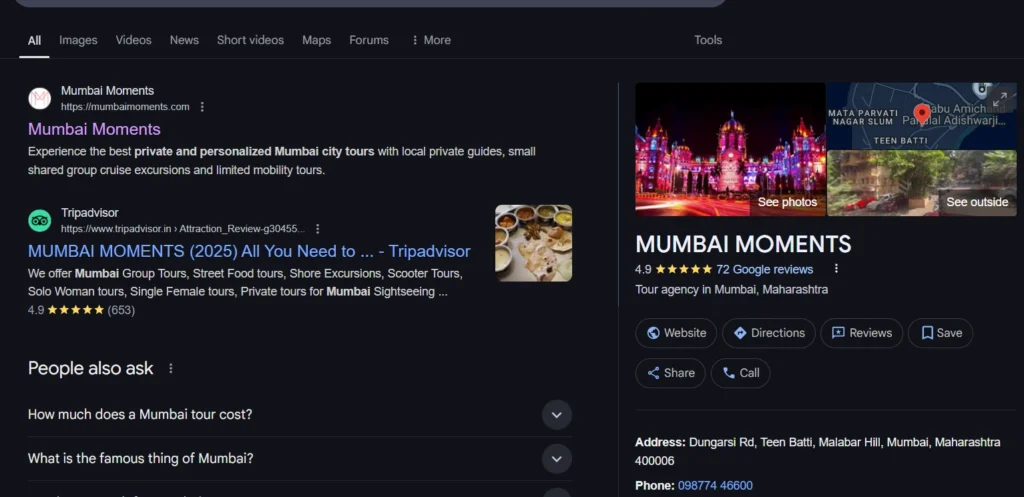
For Example: Google My Business (GMB) profile for our travel company client, Mumbai Moments, helps them to get quality leads and connect with more potential customers.
GMB optimization ensured that Mumbai Moments stands out in local searches like near me searches.
Beyond Google, you can follow this guide to list your business on Apple maps.
- Add NAP Info Consistently: NAP stands for Name, Address, and Phone number. It is important to have your NAP information consistent across your website and all local listings. This consistency helps Google verify your business’s legitimacy and boosts your local SEO rankings.
- List Your Agency on Local Business Directories: Listing your agency on local business directories increases your chances of being found by local customers. These directories often provide backlinks to your website and contribute to higher local search engine rankings, improving your overall online visibility.
We have also listed Mumbai Moments in several reputable business directories, including TripAdvisor, Foursquare, JantaReview & more to further enhance their online visibility and improve their search rankings.
By diversifying their online presence across these platforms, we aimed to increase traffic and help Mumbai Moments gain greater exposure to potential customers.
Step 6: Proper Keyword Research
- Find New and Relevant Keywords for Every Page: To increase your website’s search visibility, research and target keywords specific to each page’s content. For instance, a page on family tours in Greece should use keywords like “family trips to Greece 2025” to attract the right audience searching for that experience.
- Target Long-Tail Keywords: Long-tail keywords are more specific and less competitive, making it easier to rank for them. For example, instead of broad terms like “Europe travel,” target longer, more specific phrases like “affordable Europe travel packages for couples 2025” to attract users with clear, actionable intent.
- Use Seasonal and Trend-Based Queries: Leverage keywords that are seasonally relevant or based on current travel trends. For instance, search terms like “Summer travel in Europe 2025” or “best winter treks in Nepal 2025” can drive traffic during specific periods when travelers are planning their trips for the upcoming seasons.
How We Helped Mumbai Moments: By analyzing travel trends and seasonality, we recommended that Mumbai Moments incorporate seasonal keywords into their content. For example, using terms like “Best time to visit Mumbai” helps them connect with travelers planning their trips during peak seasons.
- Focus on Intent-Driven Keywords (Informational): Intent-driven keywords focus on what users are intending to search. For example, if you’re a Japan travel agency then doing content on “How to plan a solo trip to Japan” will target travelers who are looking for guidance for travel planning.
Step 7: Build an Authentic Content Strategy
- Establish Topical Authority with Pillar Blogs and Cluster Content: Create comprehensive “pillar” content on core topics, then link to related “cluster” content. This helps Google recognize your site as an authority on those topics.
- Create Attractive and Clear Blogs: Craft engaging, informative, and easy-to-read blog posts that solve your audience’s problems and encourage them to stay longer on your site.
- Include FAQs: Add frequently asked questions (FAQs) to address common traveler concerns. This helps both your SEO and enhances user experience by directly answering their queries.
- Update Old Blogs Based on New Google Search Console Queries: Regularly review and refresh old blog posts to include new keywords and optimize based on actual search queries, keeping your content relevant.
- Local Language Content: To reach diverse travelers, provide content in local languages (e.g., German for tourists from Germany), making your site more accessible and appealing to international audiences.
- Focus on EEAT (Expertise, Experience, Authority, Trust): Ensure your content reflects expertise in the travel field, is based on real experience, and builds trust with readers, which is critical for SEO and user engagement.
Step 8: On-Page Optimization
- Optimize Meta Titles and Descriptions: Meta titles and descriptions are crucial for SEO as they influence click-through rates from search results. Write clear, concise, and keyword-rich meta titles and descriptions that accurately reflect the page content and encourage users to click.
- Add Contextual Interlinking: Internal linking helps search engines understand the structure of your site and spreads link equity across different pages. By linking related travel blogs to one another, you can keep users engaged and improve your site’s SEO by passing authority to important pages.
- Add Hooks in Blog Introductions: A compelling hook at the beginning of your blog post grabs the reader’s attention and encourages them to continue reading. This could be a question, a statistic, or an engaging statement that sparks interest and sets the tone for the rest of the article.
- Use Alt Texts for Images Clearly and Naturally: Alt texts describe the content of an image and are essential for accessibility and SEO. Make sure your alt texts are descriptive, relevant to the image content, and include target keywords where appropriate.
- Implement Schema Markup for FAQs, Events, Reviews: Schema markup helps search engines understand the content of your pages better and enhances how your listings appear in search results. Using schema for FAQs, events, and reviews can lead to rich snippets, which make your tour activity listings more attractive and informative in search engine results.
Step 9: Community (Off-Page) Engagement
- SubReddits: Participating in relevant subreddits like r/travel and r/solotravel allows you to engage with a community of travelers. By answering questions, sharing your expertise, or providing valuable information, you can build your presence and drive traffic to your site.
- Facebook Groups: Facebook groups provide a platform to connect with travelers who share similar interests. By joining these groups, you can offer insights, share content, and promote your travel services while engaging in discussions.
For example, if you are a travel agency based in Australia, Facebook groups like “Australia Travel and Deals” and “Australia Travel Guide 2025–2026” are great places to showcase your work and attract new customers.
- Quora Communities: Quora is a great platform for establishing authority by answering questions related to travel, such as “best travel SEO strategies.” By providing thoughtful, detailed answers, you can drive traffic and showcase your expertise to potential clients.
- X (Twitter) Communities: On X (formerly Twitter), joining travel-related hashtags and spaces allows you to connect with other users in the travel niche. Engaging in conversations around these hashtags helps increase visibility and reach among people interested in travel topics.
- Telegram Groups: Telegram groups offer an opportunity to network with other travel industry professionals and bloggers. Participating in these groups helps you stay updated on industry trends and can lead to collaborations that boost your content visibility.
Explore Best Facebook Groups for Business Owners.
Step 10: Link Building for Authority
- List your site on travel directories like TripAdvisor and LonelyPlanet: Listing your website on well-established travel directories helps increase visibility among travelers actively seeking information. Being featured on reputable platforms can improve your SEO and drive more traffic to your website.
- Submit guest posts to industry-leading blogs: Writing guest posts for established travel blogs allows you to showcase your expertise to a wider audience. This not only builds your reputation but also helps you gain backlinks, improving your site’s SEO and authority.
- Collaborate with travel bloggers and influencers: Partnering with influencers and bloggers in the travel industry allows you to tap into their established audience. This collaboration can help you reach new customers, increase brand awareness, and generate high-quality traffic to your site.
- Encourage reviews on Google, Yelp, TripAdvisor, etc.: Encouraging customers to leave reviews on platforms like Google, Yelp, and TripAdvisor boosts your credibility and trustworthiness. Positive reviews enhance your online reputation, influence potential customers, and improve your SEO rankings.
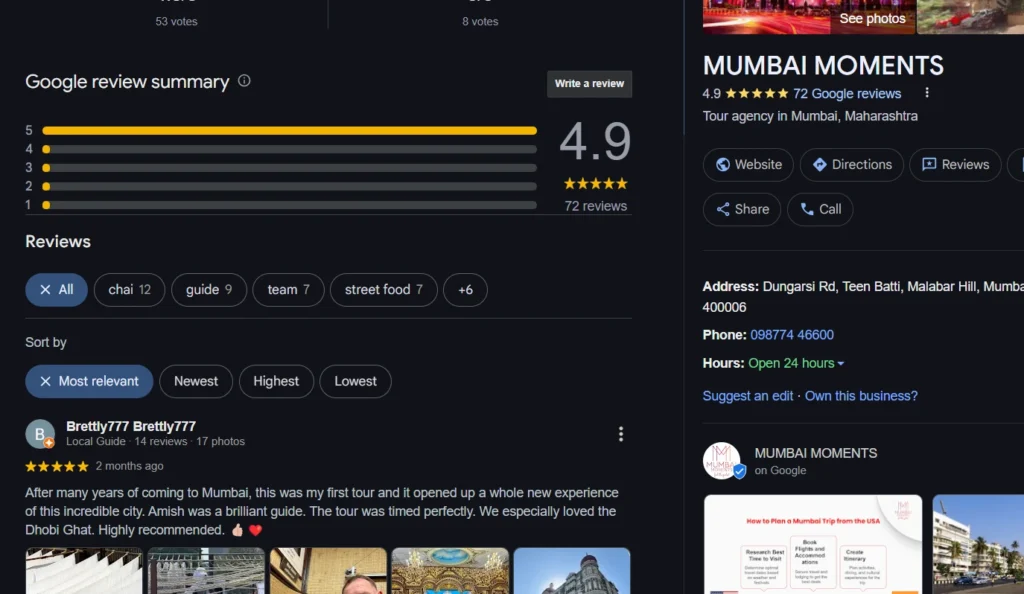
The above images shows the reviews of the Mumbai Moments.
Step 11: Monitor Results and Analytics
- Track organic traffic with Google Analytics: Google Analytics allows you to monitor the performance of your organic traffic by showing how many users visit your site through search engines. This helps you measure the effectiveness of your SEO efforts and identify areas for improvement.
- Monitor referral traffic: Referral traffic refers to visitors who come to your website through links on other websites. Tracking this traffic helps you assess which external sources are driving the most visitors and allows you to optimize your partnerships and link-building strategies.
- Check conversion rates: Conversion rates track the percentage of visitors who complete a desired action on your website, such as booking a trip or subscribing to a newsletter. Monitoring conversion rates helps you understand the effectiveness of your site’s user experience and content in driving business outcomes.
Analyze engagement time per user: Analyzing how long users stay on your site helps you gauge the level of interest and engagement. Longer engagement times typically indicate that users find your content valuable, which can positively impact your SEO rankings and user retention.
Step 12: Voice SEO and AEO (Answer Engine Optimization)
- Use conversational keywords: Optimizing for conversational keywords means targeting phrases and questions people are likely to ask when using voice search or typing in natural language. For example, instead of just “best places in 2025,” use long-tail queries like “Where is the best place to visit in 2025?” to match how people search.
- Optimize for featured snippets: Featured snippets are the boxed information that appears at the top of some search results. By structuring your content with clear, concise answers to common questions, you increase your chances of being featured, which boosts visibility and attracts more traffic to your website.
- Add FAQs on every major landing page: Including a FAQ section on your major landing pages provides valuable content for users and search engines.
- Use FAQ, HowTo, Organization, and Review schemas for rich results: Implementing structured data like FAQ, HowTo, Organization, and Review schemas helps search engines understand your content better. This can lead to rich snippets in search results, making your website more appealing and improving click-through rates.
Cheatsheet of SEO Activities
Here’s the Table containing Activities that should be done at definite Frequency (like weekly, monthly, One-time) to ensure your SEO is in the right direction.
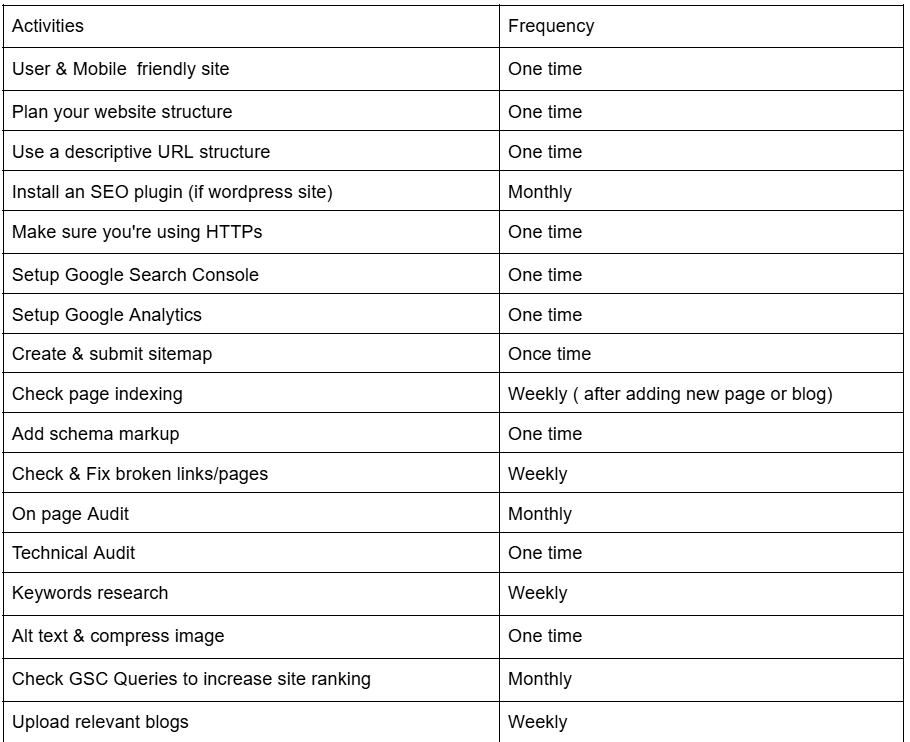
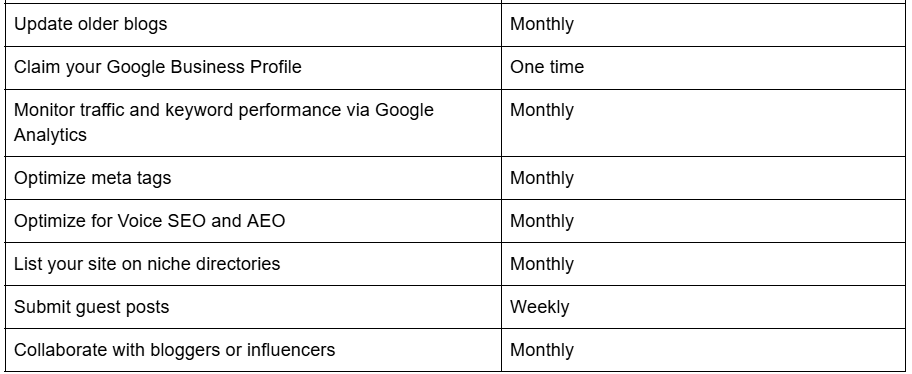
What Things You Should Avoid in Travel SEO?
- Ignoring UI/UX: A poor user interface or user experience leads to frustration and higher bounce rates. Travelers expect websites to be intuitive and easy to navigate, especially when booking trips or researching destinations.
- Bad Page Speed: Slow-loading pages are a major turnoff for visitors. A website that takes more than 2-3 seconds to load can cause potential customers to leave, especially when they are booking travel on the go. Optimizing your site for speed is essential to retain users and improve rankings.
- Spammy Backlink Lists: Building backlinks from irrelevant or low-quality sites can harm your SEO efforts. It’s more important to focus on acquiring high-quality backlinks from trusted travel websites and industry leaders to enhance your authority and credibility.
- Publishing Frequent Non-Useful AI Content: While AI-generated content can be efficient, it often lacks the personal touch or quality needed for user engagement. Posting low-quality or irrelevant content may damage your brand’s reputation and hurt SEO rankings, as search engines prioritize well-researched content.
- Keyword Cannibalization: When multiple pages on your website target the same keyword, they end up competing with each other, which can confuse search engines and dilute your page rankings. Focus on creating distinct, well-defined content for each target keyword to avoid cannibalization and ensure each page has the opportunity to rank.
- Ignoring Schema Markup: Schema markup helps search engines better understand your content and display rich results. Ignoring it means missing out on the opportunity to enhance visibility in search engine results, like featured snippets or rich cards, which can increase click-through rates.
- Not Optimizing for Mobile Devices: With more than half of travel bookings happening on mobile devices, your website must be fully responsive. Failing to optimize for mobile can result in a poor user experience, lower rankings, and lost sales opportunities from mobile users.
What Search Engines Matter for You?
- Google: Google is the most widely used search engine globally, commanding the largest share of search traffic. It is the go-to platform for users seeking answers, information, or products, making it essential for SEO strategies.
- Bing: While Bing may not have the same global market share as Google, it is still growing, particularly among professional users and those using Windows devices. It is also the default search engine for Microsoft products, making it important for certain demographics.
- Safari: Safari is the default search engine for Apple devices, such as iPhones, iPads, and Macs. Given the widespread use of Apple products, Safari has a significant user base, especially among users who prioritize privacy and seamless integration with Apple services.
- Yahoo: Yahoo is still popular in specific regions, particularly Japan, and among older demographics who are accustomed to its interface. It has a loyal user base, making it an important search engine to consider for localized SEO efforts.
- Brave: Brave is an emerging browser known for its privacy features, attracting users who are privacy-conscious. While its user base is smaller compared to the others, it is growing, especially among privacy-focused travelers who value data security.
- YouTube: YouTube is considered the best search engine for travel companies because it allows you to showcase destinations visually, building trust and excitement among viewers.
For example, Expedia uses YouTube to share immersive travel guides and destination highlights, helping viewers visualize their next vacation. Their videos often feature real experiences, boosting credibility and inspiring bookings.
- Instagram: Instagram is a favorite for travel companies because it lets them share stunning visuals that inspire people to explore new places. With proper strategy, it’s easy to reach travelers who are actively searching for new travel experience ideas.
For example is Travel Chapes, which uses Instagram to share visually striking images and reels from their guided trips around the world. Their content highlights real traveler experiences, helping build trust and wanderlust among followers.
Conclusion
SEO for the travel industry isn’t just about ranking; it’s about creating better journeys both digitally and physically. Whether you’re an agency, a solo blogger, or working within SEO for travel and tourism businesses, a smart SEO strategy for travel websites will bring you the right audience at the right time. The importance of SEO for travel websites lies in making sure your brand shows up exactly when travelers are planning their next adventure.

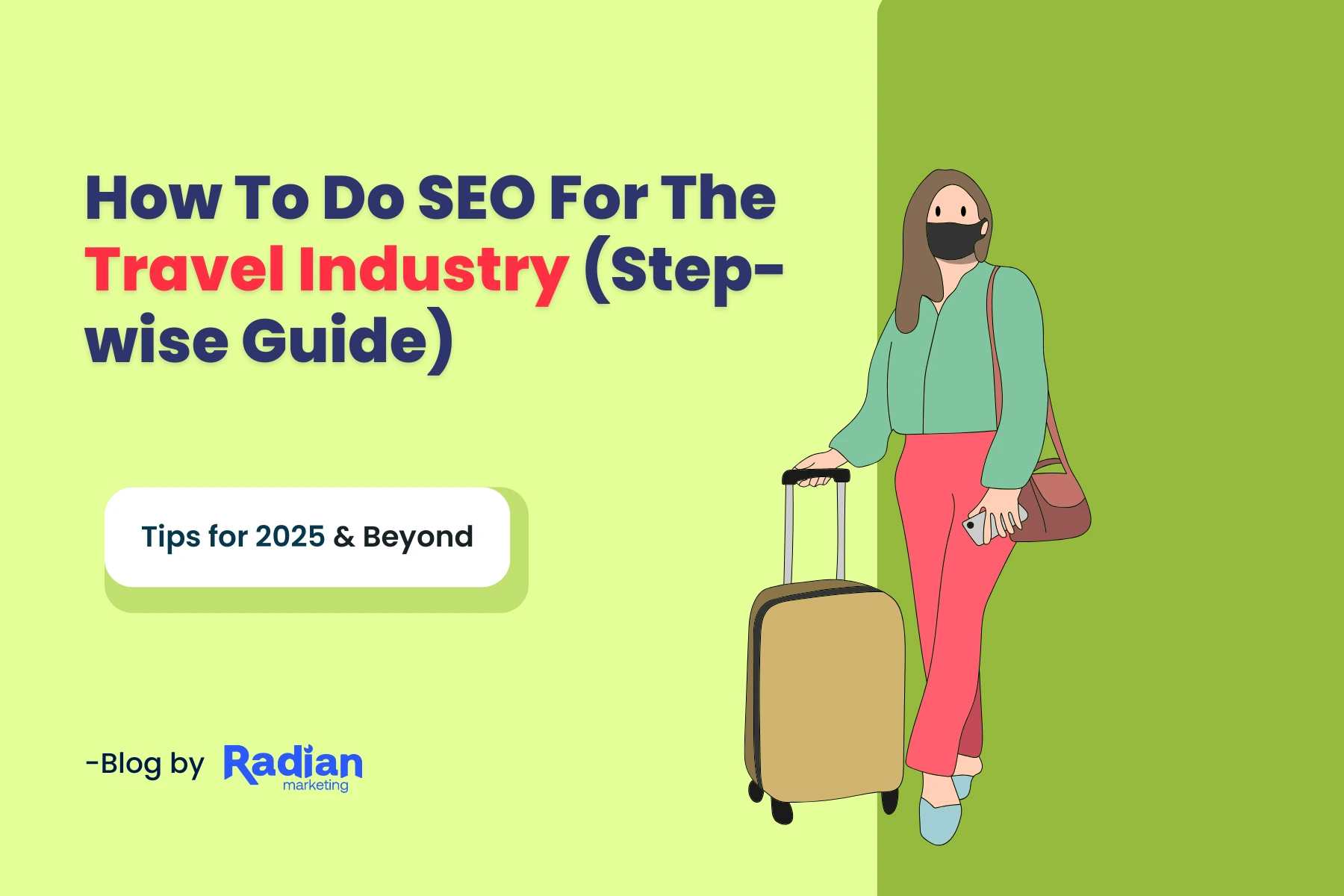

Bhaskar Gupta
Bhaskar Gupta is a passionate digital marketing practitioner and has keen interest in SEO, Social Media Strategy, Business Digital growth, and Performance marketing. He has worked with multiple brands in different industries across India and abroad. In 2022, he has set up his own digital growth and marketing agency named Radian Marketing.